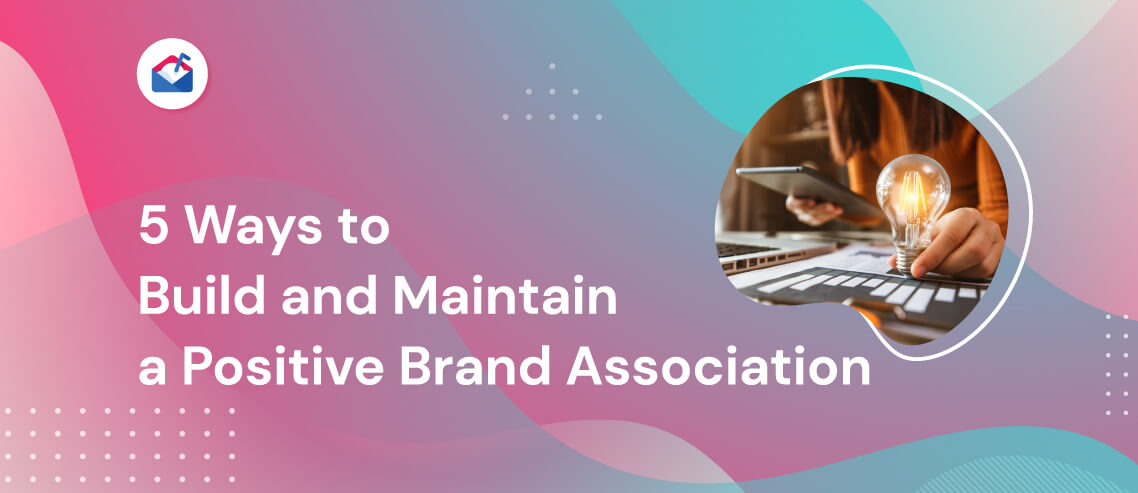5 Ways to Build and Maintain a Positive Brand Association

Contents
When someone hears your brand name, you want them to think happy, positive thoughts, not uncomfortable, negative, or irritating ones. Making sure that’s the case is called building a positive brand association.
Here, we’ll teach you five ways that you can make sure you not only craft a positive brand association but maintain it long-term.
What is Brand Association?
Brand association is the type of thoughts that pop into people’s minds when they think about your brand. For example, when you think about Mercedes-Benz, you might think of the words “luxury” or “elegance,” whereas if you think about a Volvo, the first thoughts you might have are about Sweden and safety.
People can associate both good and bad things with your brand, i.e. positive and negative associations. McDonald’s, for example, is often associated with unhealthy food and problematic farming practices, while Crest is associated with healthy teeth.
Ensuring that people associate good things with your brand is an important part of maintaining profitability and customer loyalty.
How to Build and Maintain a Positive Brand Association
Let’s jump right into it: here are five ways to make sure your brand holds a special place in your audience’s hearts.
1. Begin With Creativity
Brand association is closely linked with how your business is positioned within the market. If your brand doesn’t have anything unique about it, it will be hard for it to have any associations whatsoever. For people to attach connotations to your business, you first need to make sure it stands out in some way.
To do that, you’ll need to get creative. People are more likely to remember unique and creative branding and advertising campaigns — just think about how hearing the name GEICO stirs up images of that lovable Australian gecko, Martin.
Being creative is hard, but here are a few tricks. First, brainstorm the types of associations you want your brand to have: do you want to be known as eco-friendly? Healthy? Safe? Ethical? Friendly?
Next, think of ways to portray your company in that way without necessarily saying it outright. Creating characters can be a great way to do this as they tend to stick around in people’s minds.
2. Make It Memorable
Being creative is a good starting point, and it will usually help your brand stay memorable, but you also need to make sure that you’re being creative in the right direction. Remember, you’re not trying to construct a piece of art, you’re trying to sell a product. While a three-minute avant-garde YouTube ad featuring a variety of heavily distorted bird songs set to evolving kaleidoscopic colorscapes may be very creative and memorable, it almost definitely won’t help sell your product.
As you craft your brand image, it’s important to use creativity not for its own sake but for the purpose of building a positive association that is memorable. You can think of it like this: if you’re not creative at all, your brand won’t be memorable. But if you’re being creative without brand association in mind, then your art might end up being very memorable, but your brand won’t.
3. Cater to the Wants of the Public
A large part of building a positive brand association is making sure that your brand connects with the desires that your audience already has. Usually, those are (at some level) innate human desires, like the desire to be healthy, to look attractive, to find love, to have friends, to make money, and to stay safe.
These basic wants and needs should be the starting point of your brand association initiative. From there, you can “niche down” into more unique associations.
It’s important to make sure that you also avoid building a brand identity that comes to be associated with things that the public does not like — that’s why it’s so important to understand their wants in the first place. For example, back in the 50’s, associating your brand with smoking might have been considered cool and luxurious, but now that would be a terrible association to have.
4. Review All Customer Touch points
As you figure out what you want your brand image to be, it’s also important to keep in mind how you’re going to present that image in the first place.
To figure this out, you can look through your most common customer touch points — the ways that you interact with your customers. Every brand will have a different distribution of these. For example, some brands focus more heavily on social media, while others interact with customers more via telephone or email.
No matter what the medium, it’s important that your brand understands how to use it to leave the best impression on your customers and keep top-of-mind. For social media-focused brands, that might mean making eye-catching graphics and videos, while a brand that has a stronger brick-and-mortar presence might want to focus on a superb customer service experience (that said, all brands should make sure their customer service is top notch).
5. Have a Crisis Management Plan
No matter how much work you put into building and maintaining a positive brand association, there’s always a risk that a crisis can bring it crashing down in a matter of seconds. Just think of the BP oil spill or the recent controversy surrounding Chick-Fil-A. Both of these events caused major issues for these brands.
Make sure that you have a strategy in place to manage any possible crises. If you have the budget for it, hire a PR team before a crisis occurs.
Brand Association Examples
Brands that have worked hard to build positive associations have made lasting impacts not only on business but on culture. In fact, it’s sometimes very hard to separate certain associations from brands.
For example, when people think of luxury, they almost automatically think of brands like Mercedes-Benz, Gucci, Rolex, and Hermès. These brands have come to define what luxury means in modern culture.
Similarly, when people think of desert, they may think immediately of OREO, Ben & Jerry’s, or Hershey’s.
For electric cars, Tesla immediately comes to mind. When it comes to eCommerce, you immediately think of Amazon. For social media, examples include Facebook, Instagram, and Twitter.
The key point here is that brand associations are often a combination of the company’s product plus a few qualities of that product. So, although you likely associate “car” with BMW, Volvo, Subaru, Ferrari, and Mercedes-Benz, the associations pan out more like this:
- BMW: Car, Germany, sports, expensive
- Volvo: Car, Sweden, safe, practical
- Subaru: Car, Japan, reliable, budget-friendly, outdoors, Vermont
- Ferrari: Car, Italy, flashy, red, sports, ultra-rich
- Mercedes-Benz: Car, Germany, luxury, expensive, rich
As you can see, each initially brings to mind the product, but then customers form an association based on a brand’s unique aspects.
Key Takeaways
Consumers act on emotion, and those emotions are driven largely by associations. If you want to make your business as profitable as possible, you need to make sure your audience comes to associate your brand with positivity. The five tips we’ve provided here will put you on the path to achieving that.





